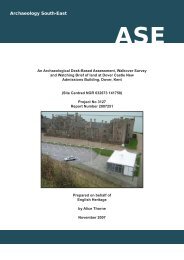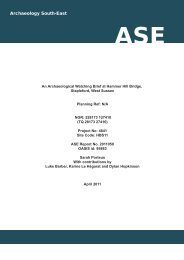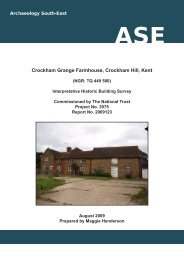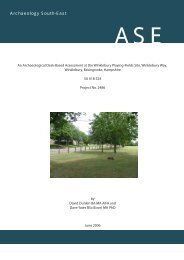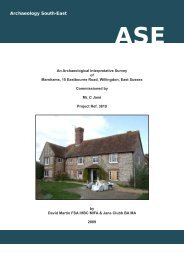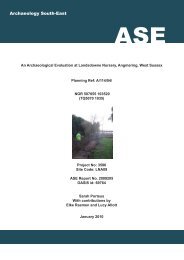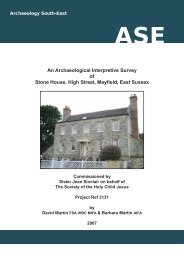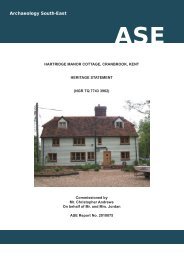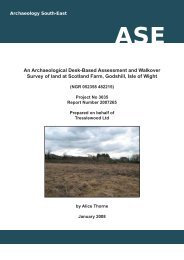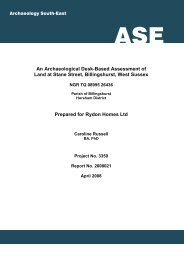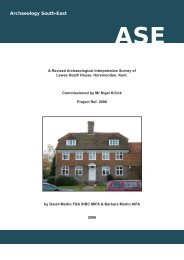ASE front cover - Archaeology South-East
ASE front cover - Archaeology South-East
ASE front cover - Archaeology South-East
You also want an ePaper? Increase the reach of your titles
YUMPU automatically turns print PDFs into web optimized ePapers that Google loves.
6.0 THE ENVIRONMENTAL SAMPLESLucy Allott6.1 Introduction<strong>Archaeology</strong> <strong>South</strong>-<strong>East</strong>2008058: Holbury Infants School, Holbury, Hampshire6.1.1 Twenty-seven bulk soil samples were taken to assist in re<strong>cover</strong>ingenvironmental remains such as wood charcoal, charred macro botanicals,bone and shell and to help establish the functions of the features sampled.These features include a series of pits some of which have multiple fills (seefor example pit [1009]; Figure 8), ditches and hearth/kiln deposits.6.2 Methods6.2.1 Environmental samples were processed using tank flotation. Flots andresidues were retained on 250µm and 500µm meshes respectively andwere air dried prior to sorting. Once dry, the flots were scanned under astereomicroscope at magnifications of x7-45 to record an overview of theircontents and establish their potential for further analysis (Table 11).Archaeological and environmental remains such as charcoal, bone, landsnail shells, pottery, burnt clay, fire cracked flint, iron fragments and glasswere removed from the residues and quantified (Table 10).6.2.2 Botanical remains were identified using modern and archaeologicalcomparative material at University College London and reference texts(Cappers et al. 2006; Jacomet 2006; Martin & Barkley 2000, Hather 2000).Where species identifications have been made the nomenclature usedfollows Stace (1991).6.3 Results6.3.1 The samples contained large amounts of uncharred vegetation includingroots and seeds (Chenopodium sp. and Sambucus nigra) as well as somemodern insects.6.3.2 Archaeobotanical remains such as charred cereal grains and weed seedswere sparse and often poorly preserved. The identifications made aretherefore limited. Occasional Triticum sp. (wheat) caryopses, and weedseeds such as Brassica sp. (mustard) were noted. Charcoal fragments inthe flots were also scarce and where present these were often 4mm howeveroverall the charcoal assemblage was small. Several hand collectedspecimens that were larger and better preserved were identified as Quercussp. (deciduous oak).6.4 Discussion6.4.1 Although sampling has confirmed the presence of occasional environmentalremains, the assemblage is unfortunately too small to provide detailedinformation regarding the functions of the features. Furthermore, modernrooting appears to have caused contamination and disturbance indicated bythe presence of modern weed seeds in some samples. However severalpoints are worth noting.6.4.2 Samples from pit/hearth feature [1057] were dominated by burnt clay whichsupports the interpretation of this feature was used as a hearth. The34© <strong>Archaeology</strong> <strong>South</strong>-<strong>East</strong>



